White Star
Line / Shaw Savill Lines
Please Note: Firefox and some iPad’s or iPhone’s, etc are not suitable
Use Internet Explorer or Google for
this page to load perfectly!
White
Star Line / Shaw Savill Lines
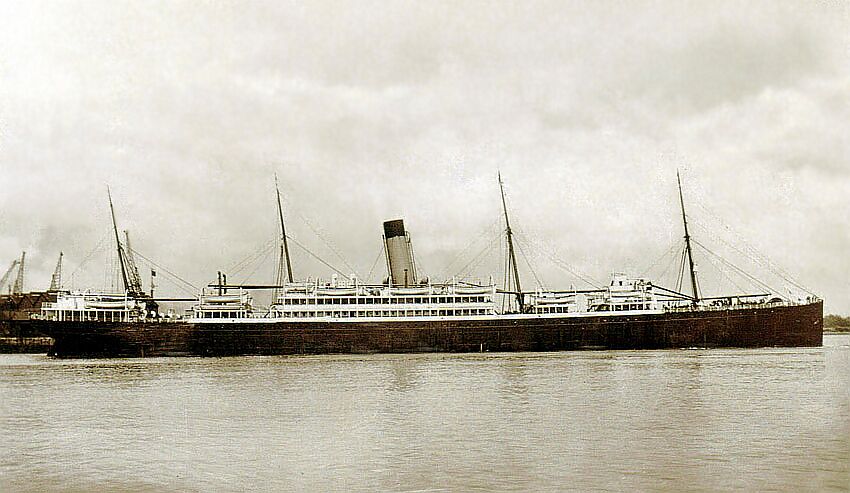
This fine
photograph shows the stately looking SS Athenic
Please Note: All photographs and postcards on this page, except those marked otherwise, are from the author’s porivate collection
This page covers three fine ships that were
built for the combined companies of White Star & Shaw Savill Lines,
operating passenger and cargo services to and from
These three large liners where known as the
“Athenic’s, because the SS Athenic was the first of the class to be
built. They were especially designed to operate on the profitable
Although these ships are generally known to be
Shaw Savill liners, they were actually built for and by the White Star Lines
house builders being the famed Harland & Wolff Shipyards in
Whilst these ships were being constructed and
completed, during 1902 and 1903 the White Star Line would be absorbed by a
company owned by that famed billionaire Banker Mr. J. Pierpoint Morgan.
“International Mercantile Marine” (IMM) was formed by him with a
capital of £24,000,000 in order to purchase the assets of “White Star
Line” and its managers “Imrie and Ismay & Company.”
J. P. Morgan and his son Jack Morgan are known
for their glamorous yachts all named Corsair and the most famed of these is the
last one being one of most glamorous super yachts ever built, the 91.4 m /
300ft SS Corsair IV – You will find my feature on her very interesting as it
covers the yacht from the Piermont days to her conversion into an ultra deluxe
but sadly a doomed cruise ship!
Regardless the White Star management changes,
these three great liners would continue to sail Down Under to
Call sign: TDNC - official registration number
115239.
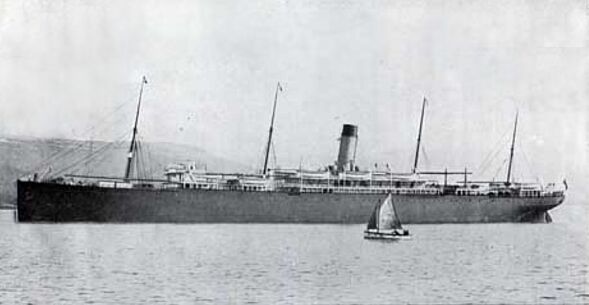
Athenic was the first to be launched of the
trio by Harland & Wolff on
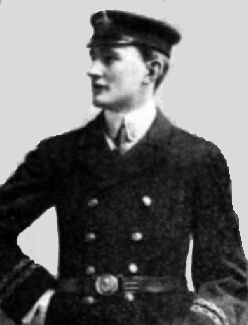
On the
maiden voyage was third Engineer, Wallis Vincent Browne
Provided
by John Davis (NZ), a distant relative of Mr Browne
SS Athenic departed on her maiden voyage from
************************
Call sign: TLWJ - official registration number
115296.
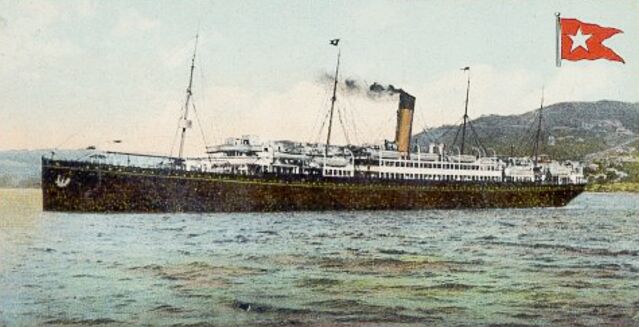
Corinthic was launched next on
************************
Call sign: TSFH - official registration number 115337.
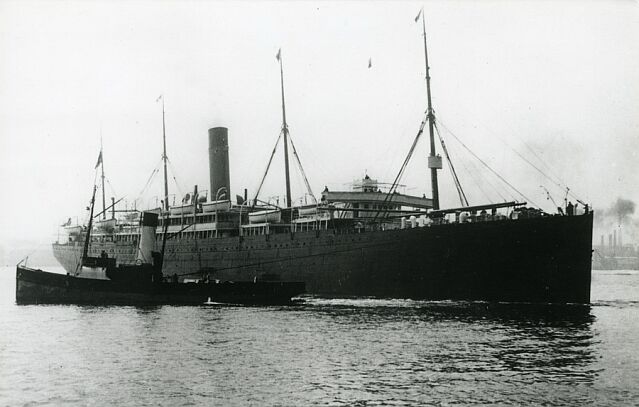
SS Ionic seen in 1903
Ionic, being the last of the Athenic series
was launched on
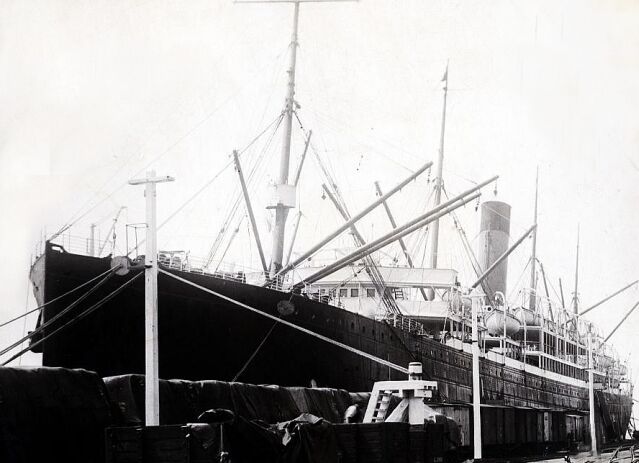
SS Ionic in port
************************
These were large
ships for the time and had accommodations for 688
passengers in three classes, with Third Class being mainly mostly used for the
assisted emigrant trade, whilst both First and Tourist classes servicing the
general tourist and transportation trade. Unusual for the time, these ships had
just one tall buff-coloured, black topped smokestack, four masts, twin screws,
4 decks, and they was fitted with a unique feature, machinery to refrigerate
the especially insulated cargo holds. They also had water ballasts. They had
quadruple expansion engines with 8 cylinders of 22, 31½, 46 & 66 inches
diameter each pair, and stroke 48 inches. Their engines were built by Harland
& Wolff, delivering 604 nominal horsepower giving the ship a service speed
of 14 knots.
As already indicated, in addition to
transporting passengers these three sisters had considerable cargo spaces,
including massive insulated cargo holds that were capable of carrying up to
98,800 carcases of frozen lamb. In addition their general cargo holds provided
an additional 8,375 tons for dry cargoes, although around 2,340 tons of space
was reserved as a coal bunker. The ships daily consumption was around eighty
tons of Welsh or ninety-two tons of
Part Three: WWI & the “Liner
Requisition Scheme”
SS Athenic. The time came that World War I had started
Athenic was located in
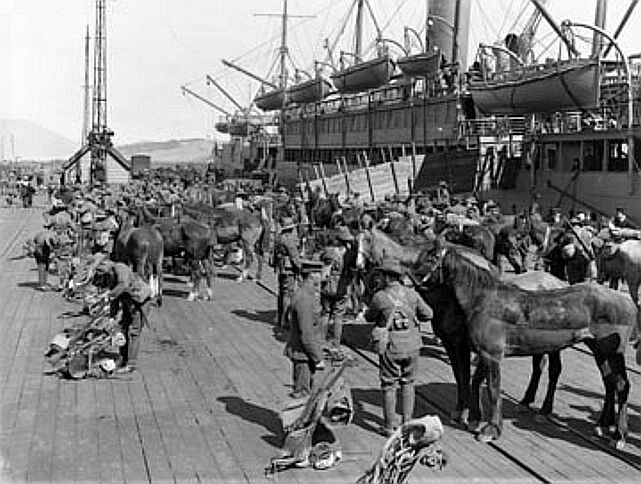
Canterbury
Mounted Rifles ready to board the Athenic
Above we see the men
dismount their horses and stow their packs. The Athenic is ready to take them on board and the horse Shute can be seen
at her side, which is ready to take the horses to the horse-boxes down below,
although some would be housed on deck. All animals had to remain standing in
their stalls for the entire voyage to
During this time it was decided by Shaw Savill
to alter her schedule and she would now sail from
An interesting wartime event occurred early in
1916. The German raider Moewe seized the British collier Westburn
on
But, due to her frozen meat-carrying capacity,
the Athenic was retained in commercial service during World War I, even though
she was taken up under the “Liner Requisition Scheme” (whilst she
was berthed in
With the war finally over the Athenic was
returned to Shaw Savill in 1919 and she recommenced her normal commercial
within the next year. Although there was a change made to her and her
sister’s schedules, for from now on until these ships concluded services,
the Athenic trio would depart
On
************************
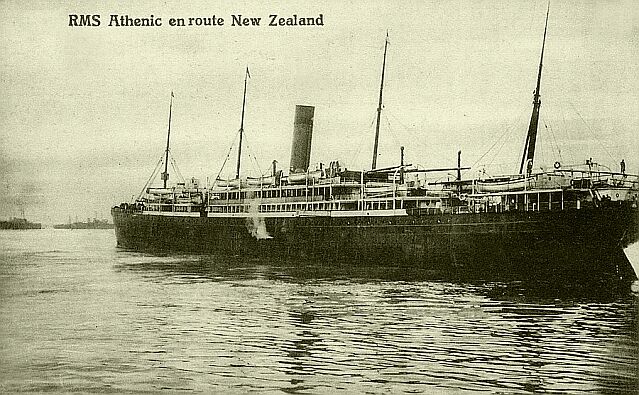
This Shaw Savill Line Postcard designates her as the RMS Athenic, but she was always designated as just “SS”
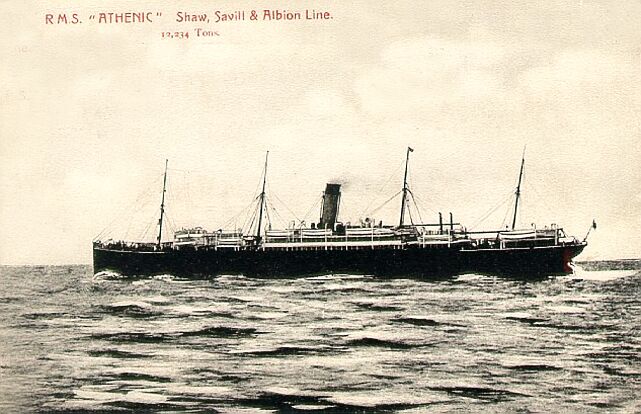
************************
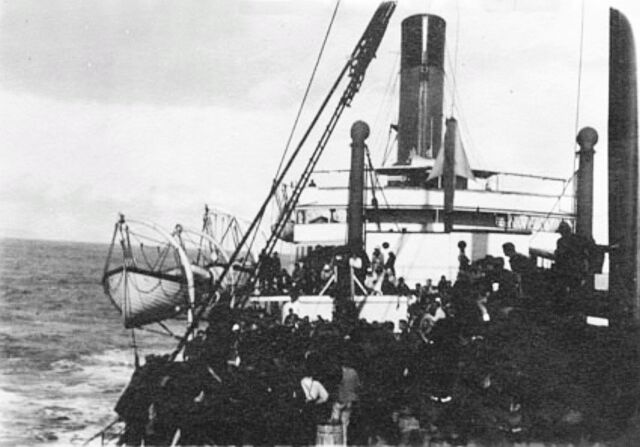
SS Corinthic
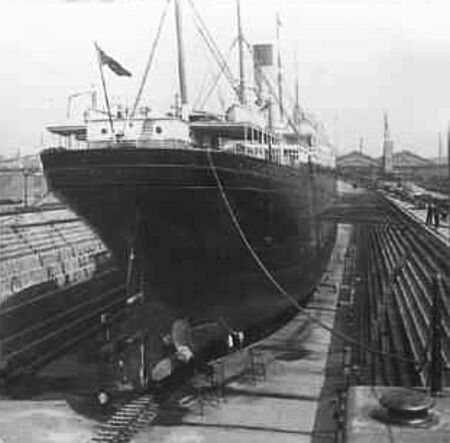
SS
Corinthic seen in dry-dock
The Dunigan family sail on SS Corinthic to New Zealand
The following details were provided by Jennifer Howard who is in the process of obtaining further information on the family history and the voyage for that matter. Thus, should there be a reader that may have any further information re this voyage, or corrections, please contact the author by using the email link at the bottom of the page.
As SS Corinthic departed a cold Southampton
late afternoon on
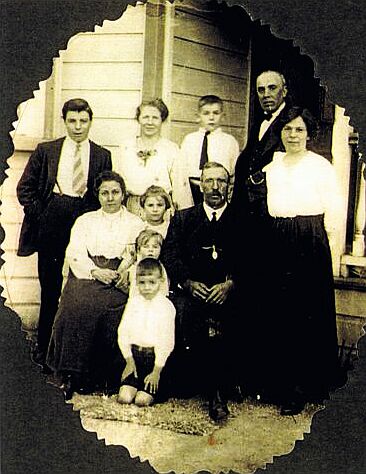
Description of the photograph above: James Dunigan (Jnr) was born in 1902 is standing on the left he is seen with his hand in his pocket. Elizabeth Dunigan, born in 1870 is seated on the left. James Dunigan (Snr) was born in 1868 is seated on the right. Jessie Dunigan, approx 29 years, is seen standing on the right next to her father. Elizabeth Dunigan (Jnr) is approx 5 years of age and she is standing between Elizabeth Snr and James Snr, directly in front of the standing NZ woman, behind the two other children.
More will be added to this story in due course.
************************

SS Ionic seen just after the war
************************
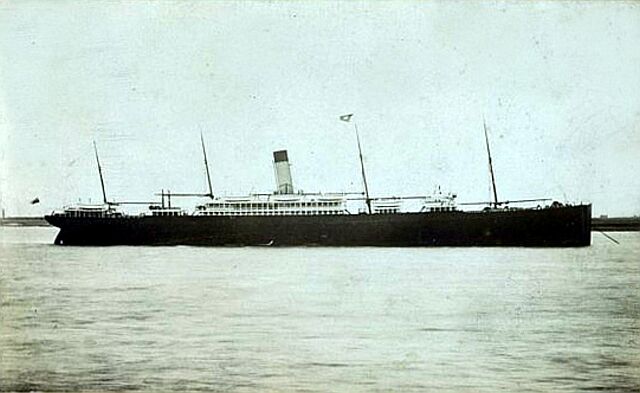
SS Athenic. In
1926, the now prefixed RMS Athenic became a two class ship offering Second and
Third Classes only. She continued her voyages, however she was sold in May 1928
to the Norwegian Company Brunn & von der Lippe of Tronsberg who extensively
rebuilt her
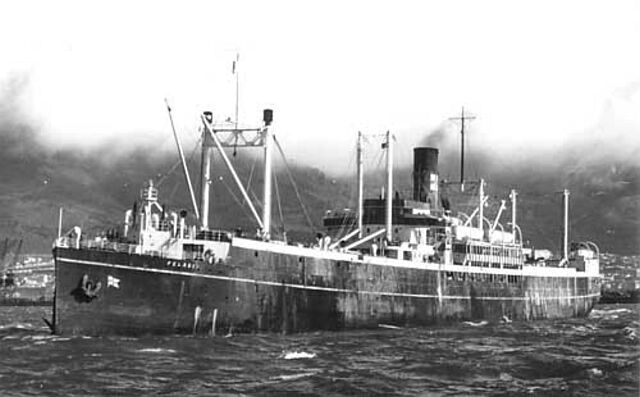
SS
Pelagos, ex Athenic certainly had the longest career of the trio, although it
was certainly an eventful one!
Twelve and a half years later she was captured
by the German Raider SS Pinguin on

Pelagos
seen after her eventful life and now at the breakers
************************
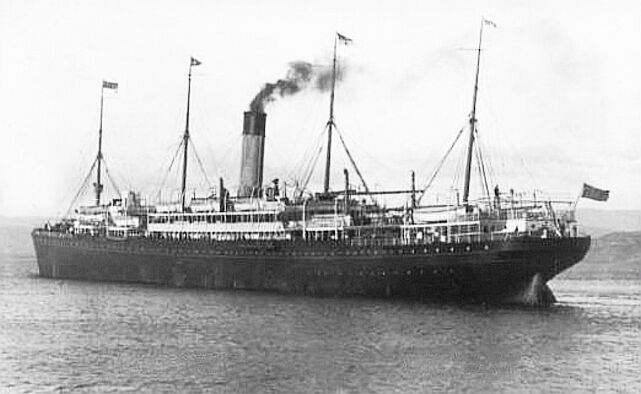
However, as I have been advised by Mr. Malcolm Scott of Blyth Northumberland that many of her fittings were purchased by the local Masonic Club and these superb items survive to this day.
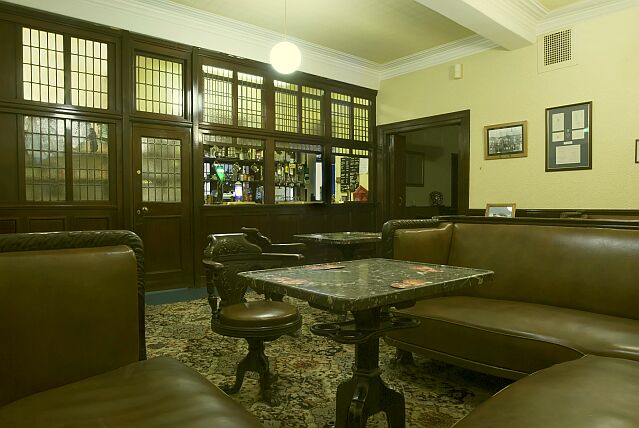
The Members Bar at the Blyth Masonic Club was originally the
SS Corinthic First Class Smoking Room Bar, including the furnishings
Photograph
by & © 2010 Mr. Bill
Coulson – Blyth Northumberland -
Below is the original text of a meeting aboard
or “at” the SS Corinthic and the ship breakers yard on
Text of Minute
dated December 29th 1931.
"Meeting of the General Committee at S/S Corinthic, Hughes
Bolckowes, Ship breaking Yard,
W.Bro. W.B. Fletcher, in the chair, also present J. J. Robson, J. R.
Parsons, J.R. Bilton, Jas. Hutchinson, T. Cooks and W.B. Parsons with Mr.
Stockdale,
Architect and
Mr. Jas. Macdonald from Shipyard.
The Committee inspected the furnishings and appointments in the first
class smoke room of the S/S Corinthic and agreed to purchase these for £75.
Also the whole of the seating in the Drawing room for £15 and such oak
panelling as required at 1/- per sq. foot.
Mr. Macdonld gave a rough estimate of £35 for taking out smoke room
Furnishings, removing same to Shipyard making ready for putting into new
Building and storing same until Building was ready.
It was agreed to give this work to the Cowpen Shipyard and Dry Dock
Co.”
Notes:
1) spelling and punctuation as in minute.
2) W. B. Parsons and J. R. Bilton were the joint
secretaries of the Blyth Masonic Hall and the Blyth Masonic club. W. B. Parsons
was an Auctioneer.
3) J. R. Parsons was a Solicitor and legal
adviser to Blyth Masonic.
4) Wm. Stockdale was a Mason from North Shields who
was engaged as the architect for the extension of the
5) The building work took place in 1932, as part of
this work the fittings referred to in the minute were used in fitting out the
Bar.
I am most grateful to
Mr. Malcolm Scott of the Blyth Masonic Club for his cooperation to this
feature, and his superb photographs of which only the first is being shown at
this stage, but more will follow soon. It is good to know that a substantial
piece of maritime history remains with us to this very day, and those who are
able can visit the club and experience the elegant surroundings that the more
wealthy passengers experienced on a fine liner the SS Corinthic between 1902 and
1931!
Thank you Malcolm for
sending the photograph and information, your contribution is certainly greatly
appreciated!
Reuben Goossens.
************************
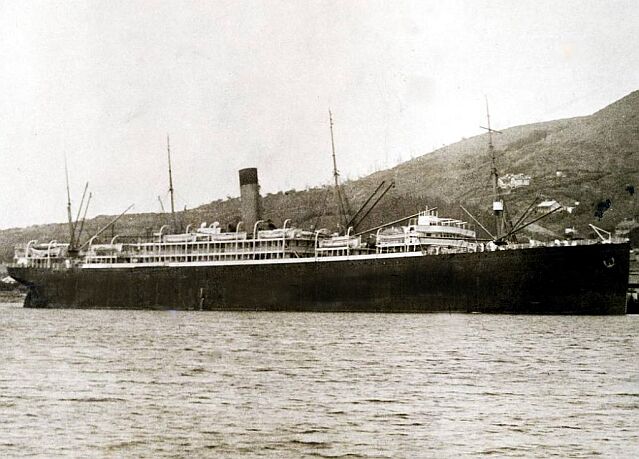
In 1936 it was decided to sell RMS Ionic after
32 long years of faithful service. During her long and successful career she
made a remarkable 79 round voyages to
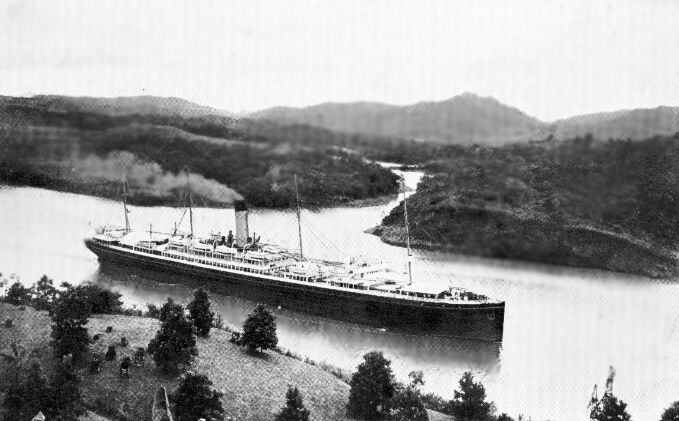
************************
Launched Launched
“ Corinthic – Yard 343
“ Launched
“ Ionic – Yard 346
“ Launched
Corinthic
– 12,231
Ionic
– 12,232
Width: 19.3m (63.3ft)
Draught 9.4m (31ft)
Screws: Twin
Speed: 14 knots.
81
to 117 Second Class
450
to 500 Third Class
Crew: 158
to 200
buff
funnel with a black top
************************
1… These
three ships were so greatly respected in New Zealand, that when it had been
announced that the last of the Athenic’s, the RMS Ionic was to be sold,
the Mayor of Auckland asked Shaw Savill if the ships bell could be presented to
the City as a memento when the ship would be in New Zealand during her final
visit. Today, this superb piece of memorabilia is located in the “
2… In
addition I will include with a tea caddy from the SS Corinthic I featuring the
Shaw Savill flag and the ships name.
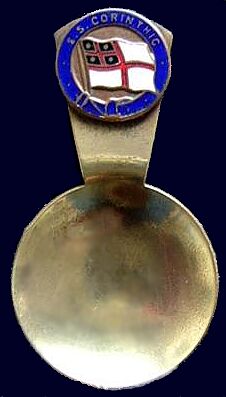
An
original SS Corinthic Tea caddy
Below
is the way we like to Remember these Great Liners!
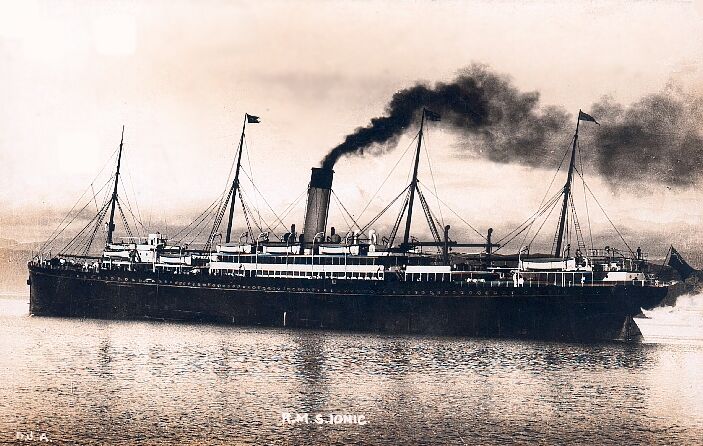
Out of the Athenic’s trio, the RMS Ionic
sailed the longest as a fulltime liner to
These ships provided such great memories and it the beginning of many fine ships to come!
The following are
all my Shaw Savill features on ssMaritime.com
1... SS Athenic Class Ships – These three fine liners built in 1902/03
************************
I watched them come, I watched them go, and I watched them die.”
************************
This notice covers all pages, although, and I have done my best to
ensure that all photographs are duly credited and that this notice is displaced
on each page, that is, when a page is updated!
ssMaritime
is owned & © Copyright by Reuben Goossens - All Rights Reserved
